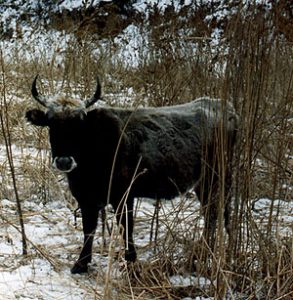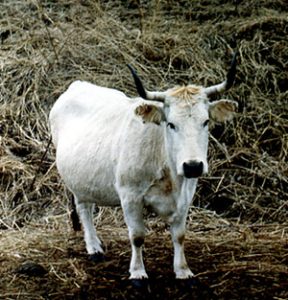Institute of Cytology and Genetics, SB RAS, Novosibirsk
Head of the Institute:
Vladimir K.Shumny, Academician of the RAS
10 Lavrentyev Ave., Novosibirsk, 630090, Russia
Tel: +(383-2) 33-35-26
Fax: +(383-2) 33-12-78, 33-34-66
email: shumny@bionet.nsc.ru
Principal researchers:
A.V.Kushnir, Doctor of Sciences (Biology)
V.N.Tikhonov, Doctor of Sciences (Biology), Professor
A.I.Vystavnoy, Ph.D. (Biology)
A.V.Terletsky, Ph.D. (Biology)
Ye.K.Minina, Ph.D. (Agriculture)
O.V.Trapezov, Ph.D. (Biology)
Project objectives
Preservation, study and breeding of economically promising animal species (aboriginal Siberian horse, horned cattle, fur-coat sheep, yak, bison, Siberian deer, wild goat, Altai snow cock, wild pig, mink and other fur animals).
Background and significance of objectives
Experimental domestication and breeding farms have been built for animals that fit Siberia, methods have been developed for monitoring physiological adaptation. The point is that the aboriginal breeds, best adapted to the harsh climatic conditions, diminish as in optimal feeding conditions they are less productive than imported stock book breeds.
To date, energy metabolism has been studied in reindeer and horned cattle at low ambient temperatures. The ratio of animals with the physical type of thermoregulation to those with the chemical one has been determined in the cow with the basic types of stress-resistance. Basic mechanisms of thermoregulation at low ambient temperatures and their association with the types of stress resistance have been determined.
Immunogenetic studies of the phylogenesis of wild, farmed and aboriginal pig have allowed the contribution of the ancestral south-eastern Asian pigs to the most important European and American breeds to be quantitatively assessed, and the share of the Chinese pig’s genofond in novel breeds across Siberia and FSU to be established.
A biological mechanism has been discovered in In Yakutian horse, that underlies the formation of discordance in the genotypic and phenotypic characters in response to a change in ecological conditions of confinement and breeding. Studying the gene pool of Siberian meat-wool sheep revealed possibilities of prediction of high prolific productivity following two first lambings, a high correlation between maturity age and living weight at birth has been found.
Microevolutionary processes of genotype formation have been studied in a few dozens of modern dog breeds of the Europe and Asia. Vectors of geographic migration have been established by the marker alleles of ancestral forms of modern breeds in Siberia, Central Asia, Japanese Islands and Korean Peninsula.
The possibility of acclimatisation of European bison has been discussed, techniques for hybridisation with Altai yak have been developed.
Possibilities of immunogenetic control, prediction and elevated pant deer productivity have been scrutinised.
Biology and possibilities for preservation, domestication and farm-breeding of Altai snow cock have been studied.
Biology and possibilities for preservation, domestication and farm-breeding in Siberia of mutant forms of American mink and Far East sea beaver have been studied.
Research plan: approaches and methods
Immunogenetic monitoring is being conducted on the macroevolution of the populations of rare species of aboriginal animals, genetic and physiological techniques have been developed for assessing the viability of populations by the example of many year studying the phylogenesis amd microevolution of polytyped species (wild and farmed pig, aboriginal horses and many Asian dog breeds), models have been studied of microevolutionary processes under different farming conditions on animals with different reproductive coefficient.
Expected results
Recommendations will be given as to how preserve and effectively benefit from farming the aboriginal and domesticated animals that are economically promising for Siberia.
List of publications of participants related to the project
-
Kniazev S.P., Tikhonov V.N., Kotren Ye.G. Populational-genetic analysis of geen pool microevolution in modern horse breeds // Reports to Russ.Agric.Acad.Sci.. ñ 1998. ñ π 1. ñ p. 36-38.
-
Kniazev S.P., Tikhonov V.N., Tanabe Yu., Morozov P.S. Formation of genetics polymorhism as associated with the phylogenesis and microevolution in dog (Canis familiaris L.) // Genetika. ñ 1998. ñ V. 34, π 10. ñ p. 1001-1009.
-
Kushnir A.V., Oblap R.V., Yasinetskaya N.A. Intraspecific differentiation in Przevalskjj horse and domestic horse by 5 molecular-genetic markers // Tsitologiya i Gnetika, ñ 1998. ñ V. 32, π 3. ñ p. 10-17.
-
Kushnir A.V., Stolpovskiy Yu.A., Oblap R.V. Phenotypic and Genetical Structure of Ukrainian Grey Breed of Cattle // Ibid, 1998. ñ V. 32, π 5. ñ P. 67-74.
-
Kushnir A.V., Terletskiy A.V. Heard structure of Holstein black-white cattle with respect to stress-resistance in the dynamics of lactation periods // Math. Inter. Conf. “DNA Technologies”. ñ Kyyv: Agrarna Nauka, 1997. ñ p. 37-39.
-
Lukyanov Yu.P. Altai snow cock. ñ Moscow: Coop. edition by 4SIS GmyKh and “Intergraf Servis”, 1993. ñ 24 p.
-
Popov V.A. On some results of bison acclimatisation (Bison bonasus L.) in Gorny Altai // Sibirsky Ekologicheskiy Zhurnal. ñ 1996. ñ π 2. ñp. 137-141.
-
Sokolov A.Ya., Kushnir A.V. Thermoregulation and bioenergetics of reindeer ñ Novosibirsk: SB RAS Publishing House, 1997. ñ 179 p (monograph).
-
Tikhonov V.N., Kotren Eu.G., Kniazev S.P. Populational and genetic parameters of aboriginal Yakutian horse as associated with the phylogeny of modern breeds of domestic horse Equus caballus // Genetika. ñ 1998. ñ V. 34, π 6. ñ P. 796-809.
-
Shumny V.K., Kushnir A.V., Tikhonov V.N. Some results on and prospects for work on the gene pool of wild and aboriginal animals of Siberia // Sibirsky Ekologicheskiy Zhurnal. ñ 1994. ñ π 1. ñ p. 75-85.
-
Glazko V.I., Oblap R.V., Yasinezkaja N.I. Kushnir A.V. Comparative analysis of genetic intraspecies differentiation in domestic horse and Przewalski’s horse // XXVI th Intern.Conf. on animal Genetics, New Zeland. ñ 1998. ñ P. 26.
-
Knyazev S.P., Tikhonov V.N. Genogeographic Study of Craniologic Peculiarities of Swine Phylogenesis and Precocity // Ibid.
-
Knyazev S.P., Tikhonov V.N., Cothran E.G. Population genetic analysis of microevolution of genofund of horse breeds // The Reports of Russian Academy Agricultural Sciences, N-Y., 1998. ñ P. 36-38.
-
Knyazev S.P., Tikhonov V.N., Tanabe Y. Biodiversity at different levels of breed development: genetic polymorphism of Siberian and Korean native dog populations // Proc. YIII World Conf. on Animal Production, (Seoul, Korea),1998. ñ P. 662-663.
-
Knyazev S.P., Tikhonov V.N., Tanabe Y., Morozov P.S. Development of genetic polymorphism of Canis familiaris and microevolution // Russian Jurn. of Genetics, New-York, 1998. ñ Vol. 34, π 10.
-
Sharshov A.A., Graphodatsky A.S.,Biltueva L.S. G-banding homologies in musk ox, ovibos moshatus, and other bovids // Hereditas. ñ 1995. ñ Vol. 122. ñ P. 185-187.
-
Tikhonov V.N. Polyfactorial system of litter size control in pigs dependent on genetic blood group systems // Proc. of the 6th World Congress on Genetic Applied to livestock Production. ñ 1998. ñ Vol. 26. ñ P. 457-460.
-
Tikhonov V.N., Bobovich V.E. The Role of Chinese Pig Gene Pool in Development of Russian and FSU Breeds // Proc. of Intern. Conf. on Pig Production. Beijing, China, 1998. ñ P. 77-80.
-
Tikhonov V.N. Influences of South East Asian Pig Gene on Development of the Most Common World Breeds // Proc. of Intern. Conf. on Pig Production. Beijing, China, 1998. ñ P. 128-131.
-
Tikhonov V.N., Cothran E.G., Knyazev S.P. Population Genetic Parameters of Aboriginal Yakut Horses As Related to the Phylogeny of Modern Breeds of the Domestic Horse Equus Caballus L. // Russian Jour. of Genetics, N-Y.,1998. ñ Vol. 34, π 6. ñ P. 654-666.
Native Yakutian cattle
Ukrainian Grey breed of cattle
Native Yakutian horses
A cow of Highland breed
Native Kulunda sheep





